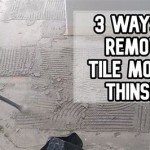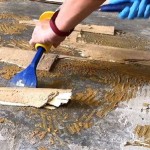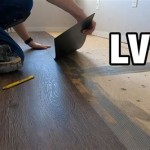How To Fix Vinyl Flooring In Bathroom
Vinyl flooring is a popular choice for bathrooms due to its water resistance, durability, and relatively low cost. However, like any flooring material, vinyl can be subject to damage over time. Scratches, tears, loose seams, and bubbling are common issues. Addressing these problems promptly is crucial to prevent further deterioration and maintain the aesthetic appeal of the bathroom. This article provides a comprehensive guide on how to fix various types of damage to vinyl flooring in a bathroom, offering practical solutions for homeowners and professionals alike.
Identifying the Damage and Required Tools
Before attempting any repairs, it is essential to accurately identify the type and extent of the damage. This will dictate the appropriate tools and materials required for the repair. A careful visual inspection is the first step. Look for: small scratches and scuffs, which mostly affect the surface layer; gouges and deeper scratches that penetrate the material; tears or cuts, especially near doorways or fixtures; loose seams where sections of vinyl meet; bubbling or blistering, indicating moisture trapped underneath; and cracks, which can appear in older or poorly installed vinyl.
Once the damage is assessed, gather the necessary tools and materials. A basic toolkit for vinyl flooring repair should include: a utility knife with sharp blades; a seam roller; a heat gun or hairdryer; vinyl flooring adhesive; seam sealer; a putty knife; a straightedge or ruler; a matching vinyl repair kit (containing filler compounds and textures); a clean cloth; and safety glasses.
Repairing Scratches and Scuffs
Superficial scratches and scuffs are often the easiest to fix. Start by cleaning the affected area thoroughly with a mild detergent and water. Rinse and dry completely. For minor scuffs, a non-abrasive cleaning pad or a specialized vinyl floor cleaner may be sufficient to remove the marks. Apply the cleaner according to the manufacturer's instructions and buff the area gently.
For deeper scratches, a vinyl repair kit is usually required. These kits typically include a range of colored fillers that can be mixed to match the existing flooring. Select the appropriate color or blend colors according to the kit’s instructions. Use a putty knife to apply a small amount of the filler to the scratch, ensuring it fills the depression completely. Remove any excess filler and smooth the surface flush with the surrounding flooring. Allow the filler to dry completely, following the drying time specified in the kit's instructions. Some kits may require the application of a textured paper or embossing tool to replicate the original flooring texture.
After the filler has dried, carefully inspect the repair. If the color or texture is not a perfect match, make adjustments as needed. A clear acrylic sealant can be applied over the repaired area to protect it and blend it seamlessly with the rest of the floor.
Addressing Tears and Cuts
Tears and cuts in vinyl flooring require a more involved repair process. The first step is to clean the area around the tear thoroughly. If the tear is small and clean, a vinyl repair kit may still be effective. However, for larger tears or cuts, a patch may be necessary.
To create a patch, obtain a piece of matching vinyl flooring. This can sometimes be salvaged from a remnant or an inconspicuous area of the bathroom, such as under the vanity. Place the patch over the damaged area and use a sharp utility knife and a straightedge to carefully cut around the perimeter of the patch, cutting through both the patch and the existing flooring. Remove the damaged section of flooring and ensure the resulting opening is clean and square.
Apply vinyl flooring adhesive to the subfloor in the opening. Carefully position the patch into the opening, ensuring it fits snugly and the edges align perfectly with the surrounding flooring. Use a seam roller to firmly press the patch into place and remove any air bubbles. Wipe away any excess adhesive that squeezes out from the seams. Place a heavy object, such as a stack of books, on top of the patch to keep it firmly in place while the adhesive dries. Allow the adhesive to dry completely, following the manufacturer's instructions.
Once the adhesive has dried, apply a seam sealer along the edges of the patch to prevent water from seeping underneath. This is particularly important in a bathroom environment where moisture is prevalent. Smooth the seam sealer with a clean cloth and allow it to dry completely.
Repairing Loose Seams
Loose seams in vinyl flooring are another common problem, often caused by improper installation or wear and tear. To repair a loose seam, begin by cleaning the seam thoroughly to remove any dirt or debris. Use a vacuum cleaner with a crevice attachment to remove loose particles.
If the vinyl is still flexible, carefully lift the edges of the seam and apply vinyl flooring adhesive to the subfloor underneath. Use a putty knife to spread the adhesive evenly. Align the edges of the vinyl and press them firmly together. Use a seam roller to ensure a tight bond.
If the vinyl is stiff or brittle, it may be necessary to soften it with heat. Use a heat gun or hairdryer to gently warm the vinyl along the seam. Be careful not to overheat the vinyl, as this can cause it to scorch or melt. Once the vinyl is pliable, apply adhesive and press the edges together as described above. Clean away any excess adhesive with a damp cloth.
After the adhesive has dried, apply a seam sealer along the seam to prevent water penetration. This is essential in a bathroom to prevent moisture damage to the subfloor. Allow the seam sealer to dry completely.
Addressing Bubbling and Blistering
Bubbling or blistering in vinyl flooring typically indicates that moisture is trapped underneath. This can be caused by leaks, spills, or inadequate subfloor preparation. To address bubbling, the source of the moisture must first be identified and eliminated.
Once the moisture source is resolved, the repair process depends on the size and severity of the bubble. For small bubbles, it may be possible to puncture the bubble with a small needle or utility knife and release the trapped air or moisture. Press down on the area to flatten it and apply weight to hold it in place while the adhesive dries. It is important to apply a small amount of vinyl adhesive under the bubble through the hole before pressing down to bond the vinyl back to the subfloor.
For larger bubbles or blisters, a more extensive repair may be required. Use a utility knife to carefully cut out the affected area, creating a clean, square opening. Inspect the subfloor underneath for any signs of mold or damage. If mold is present, it must be treated with a mold-killing solution before proceeding. If the subfloor is damaged, it may need to be repaired or replaced.
Apply vinyl flooring adhesive to the subfloor in the opening. Cut a patch of matching vinyl flooring to fit the opening. Carefully position the patch into the opening, ensuring it fits snugly and the edges align perfectly with the surrounding flooring. Use a seam roller to firmly press the patch into place and remove any air bubbles. Wipe away any excess adhesive that squeezes out from the seams. Place a heavy object on top of the patch to keep it firmly in place while the adhesive dries. Allow the adhesive to dry completely, following the manufacturer's instructions.
After the adhesive has dried, apply a seam sealer along the edges of the patch to prevent water from seeping underneath. This is particularly important in a bathroom environment where moisture is prevalent. Smooth the seam sealer with a clean cloth and allow it to dry completely.
By following these steps, it is possible to repair a wide range of damage to vinyl flooring in a bathroom. However, for extensive damage or complex repairs, it is often best to consult a professional flooring contractor.

How To Install Vinyl Plank Flooring In A Bathroom Fixthisbuildthat

How To Fit Vinyl Flooring In A Bathroom Turning House Into Home

How To Install Vinyl Plank Flooring In A Bathroom As Beginner Home Renovation

How To Install Vinyl Plank Flooring In A Bathroom

How To Install Vinyl Plank Flooring In A Bathroom Fixthisbuildthat

How To Install Vinyl Sheet Flooring A Erfly House

Fix Vinyl Floor Tiles Lifting Or Ling Up The Money Pit

How To Install Sheet Vinyl Floor Decor Adventures

How To Install Vinyl Plank Flooring In A Bathroom As Beginner Home Renovation

How To Install Vinyl Plank Flooring In A Bathroom Fixthisbuildthat
See Also







